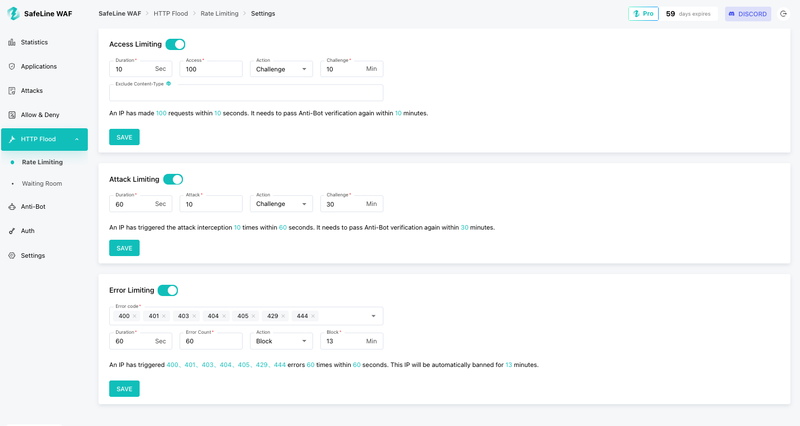In today's threat landscape, automated attacks—like credential stuffing, scraping, and DDoS—are growing more sophisticated. That’s where rate limiting comes in: a simple yet powerful way to throttle abusive behavior before it reaches your app.
SafeLine WAF, a modern and intelligent web application firewall, offers a robust rate limiting engine that's built for precision, performance, and future extensibility.
Here’s an inside look at how SafeLine handles rate limiting today—and what’s coming next.
Current Approach: IP-Based Rate Limiting
SafeLine’s current rate limiting system operates primarily at the IP level. It tracks how many requests are made from each source IP within a defined time window—typically per second.
Once a client exceeds the configured threshold, SafeLine takes automated action:
- Temporary IP blocking during a cooldown period
- Anti-bot verification (e.g., JavaScript challenge or CAPTCHA)
- Permanent blacklisting for confirmed malicious IPs
This approach is especially useful for endpoints like /api/login, where brute-force scripts often hammer the backend. SafeLine detects these high-frequency patterns and stops them early—before damage is done.
Limitation: IP Rotation Can Bypass Protection
While effective, IP-based controls alone have limits. More advanced attackers can rotate through IPs using botnets, proxies, or CDNs, effectively dodging per-IP enforcement.
SafeLine is already addressing this challenge by working on a more context-aware, multi-dimensional rate limiting system.
What’s Coming: Smarter, Fine-Grained Rate Limiting
The SafeLine team is rolling out enhancements that allow rate limiting based on much more than just IP addresses. Planned improvements include:
Per-Endpoint Policies
- Apply tighter thresholds to sensitive paths like
/login,/checkout, or/api/payment.
User-Agent–Based Rules
- Identify and throttle suspicious clients based on known bot patterns.
Custom Rules Based on:
- Request headers
- Cookies
- Query strings
- URI paths
This enables per-client, per-route behavior modeling—ideal for modern, complex apps with dynamic traffic patterns.
On the Horizon: Device Fingerprinting
To counter IP spoofing and botnet evasion tactics, SafeLine is developing device fingerprint–based rate limiting.
This will:
- Use browser behavior, JS execution context, TLS signatures, and more to identify users
- Assign a unique fingerprint ID to each client
- Enforce limits even if the attacker changes IP addresses
By anchoring rate limiting to a fingerprint rather than IP alone, SafeLine will drastically reduce evasion and false negatives.
Final Thoughts
SafeLine WAF already provides a strong foundation for rate limiting via its IP-based enforcement. But with upcoming features like fine-grained rules and device fingerprinting, it’s evolving into a far more intelligent engine—one that adapts to complex traffic patterns and emerging threats.
Whether you're defending against bots, scrapers, or brute-force attacks, SafeLine is building the tools to keep your web applications secure.




Top comments (0)